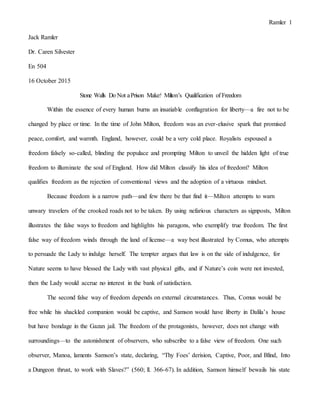Report
Share

Recommended
Recommended
More Related Content
Featured
Featured (20)
How Race, Age and Gender Shape Attitudes Towards Mental Health

How Race, Age and Gender Shape Attitudes Towards Mental Health
AI Trends in Creative Operations 2024 by Artwork Flow.pdf

AI Trends in Creative Operations 2024 by Artwork Flow.pdf
Content Methodology: A Best Practices Report (Webinar)

Content Methodology: A Best Practices Report (Webinar)
How to Prepare For a Successful Job Search for 2024

How to Prepare For a Successful Job Search for 2024
Social Media Marketing Trends 2024 // The Global Indie Insights

Social Media Marketing Trends 2024 // The Global Indie Insights
Trends In Paid Search: Navigating The Digital Landscape In 2024

Trends In Paid Search: Navigating The Digital Landscape In 2024
5 Public speaking tips from TED - Visualized summary

5 Public speaking tips from TED - Visualized summary
Google's Just Not That Into You: Understanding Core Updates & Search Intent

Google's Just Not That Into You: Understanding Core Updates & Search Intent
The six step guide to practical project management

The six step guide to practical project management
Beginners Guide to TikTok for Search - Rachel Pearson - We are Tilt __ Bright...

Beginners Guide to TikTok for Search - Rachel Pearson - We are Tilt __ Bright...
Unlocking the Power of ChatGPT and AI in Testing - A Real-World Look, present...

Unlocking the Power of ChatGPT and AI in Testing - A Real-World Look, present...
One Drive Milton paper
- 1. Ramler 1 Jack Ramler Dr. Caren Silvester En 504 16 October 2015 Stone Walls Do Not aPrison Make:i Milton’s Qualification of Freedom Within the essence of every human burns an insatiable conflagration for liberty—a fire not to be changed by place or time. In the time of John Milton, freedom was an ever-elusive spark that promised peace, comfort, and warmth. England, however, could be a very cold place. Royalists espoused a freedom falsely so-called, blinding the populace and prompting Milton to unveil the hidden light of true freedom to illuminate the soul of England. How did Milton classify his idea of freedom? Milton qualifies freedom as the rejection of conventional views and the adoption of a virtuous mindset. Because freedom is a narrow path—and few there be that find it—Milton attempts to warn unwary travelers of the crooked roads not to be taken. By using nefarious characters as signposts, Milton illustrates the false ways to freedom and highlights his paragons, who exemplify true freedom. The first false way of freedom winds through the land of license—a way best illustrated by Comus, who attempts to persuade the Lady to indulge herself. The tempter argues that law is on the side of indulgence, for Nature seems to have blessed the Lady with vast physical gifts, and if Nature’s coin were not invested, then the Lady would accrue no interest in the bank of satisfaction. The second false way of freedom depends on external circumstances. Thus, Comus would be free while his shackled companion would be captive, and Samson would have liberty in Dalila’s house but have bondage in the Gazan jail. The freedom of the protagonists, however, does not change with surroundings—to the astonishment of observers, who subscribe to a false view of freedom. One such observer, Manoa, laments Samson’s state, declaring, “Thy Foes’ derision, Captive, Poor, and Blind, Into a Dungeon thrust, to work with Slaves?” (560; ll. 366-67). In addition, Samson himself bewails his state
- 2. Ramler 2 of captivity, finding himself in unbreakable chains and believing that he has failed to accomplish God’s purpose (552; ll. 35-42). Moreover, Comus enjoys his smug position of dominance over his captive Lady, playing arbiter of freedom by waving his wand in the air. The Lady is undaunted; not even angels that soar above enjoy such liberty. True freedom lies not in authorizing license or in loosening physical shackles—Milton qualifies freedom differently. In opposition to indulgence, true freedom requires virtue. Thus, the Lady could be invincible through her virtuous chastity, and Samson could languish more abjectly in the lap of Dalila than in the bitterest stockade. Milton’s homily to England is clear: “Love virtue, she alone is free” (114: l. 1019). Furthermore, true freedom exists not in circumstance but in the mind. As a result, the Lady could lift her chin to mighty Comus and say, “Thou canst not touch the freedom of my mind” (105; l. 663). Additionally, a penitent Samson recognizes his former bondage of the mind. “The base degree to which I now am fall'n, these rags, this grinding, is not yet so base as was my former servitude, ignoble, unmanly, ignominious, infamous. True slavery, and that blindness worse than this that saw not how degenerately I serv'd” (561-562; ll. 414-419). Thus, after his purification, Samson counts his prison as a “house of liberty” (574; l. 949). By recognizing the freedom in in his mind, wrought through introspection in his cathartic hermitage, Samson frees himself from spiritual shackles and delivers Israel from despotic domination. Dull imitations of true freedom radiate more darkness. Only through the spectacles of a virtuous mind can one see the light of true virtue—even if one is blind. Only through passing through cathartic fire can one feel freedom’s warmth. False understandings of freedom shroud truth from the public eye, but a blind poet sees freedom in its glorious element. Milton views freedom as a purifying and consuming fire—unfit for the unholy but vital for the virtuous.
- 3. Ramler 3 Works Cited Milton, John. John Milton: Complete Poems and Major Prose. Ed. Merritt Y. Hughes. New York: Odyssey, 1957. Print. i Several phrases echo Richard Lovelace’s “To Althea from Prison,” written during the life of Milton.